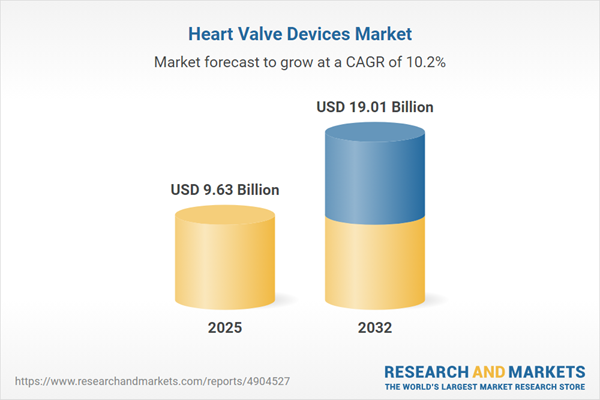Speak directly to the analyst to clarify any post sales queries you may have.
The heart valve devices market is evolving rapidly, driven by changing standards of care, advances in treatment methods, and supply chain innovation. Senior decision-makers require up-to-date, actionable insights to navigate this complex environment, ensuring optimal strategy and sustainable growth.
Market Snapshot: Heart Valve Devices Market Size and Competitive Dynamics
The heart valve devices market is currently valued at USD 8.74 billion and is projected to reach USD 19.01 billion by 2032, with an expected compound annual growth rate of 10.19%. Market expansion is supported by increased uptake of advanced cardiac interventions and robust research funding. Industry leaders are refining product portfolios, adopting digital health tools, and forming strategic partnerships to address evolving regulations and the complexity of global healthcare delivery. Trends toward minimally invasive procedures are broadening patient access, while digital healthcare adoption empowers manufacturers to adapt across varied regional markets and operational landscapes.
Scope & Segmentation of the Heart Valve Devices Market
- Valve Position: Solutions are designed for aortic, mitral, pulmonary, and tricuspid valve replacement or repair, providing tailored care for a wide range of patient needs and health profiles.
- Product Type: Offerings encompass mechanical valves, such as bileaflet and tilting disc designs, alongside biological valves made from bovine and porcine tissue, allowing for selection based on durability and compatibility requirements.
- Age Group: Devices serve both adults and pediatric patients, supporting clinical intervention for acute and chronic valve concerns at every stage of the patient lifecycle.
- End User: Hospitals and ambulatory surgical centers benefit from products designed for acute interventions and longer-term patient management, ensuring flexible care models.
- Geographic Coverage: Presence extends across the Americas, Europe, Asia-Pacific, and the Middle East and Africa, each region navigating unique regulatory, access, and reimbursement landscapes.
- Companies Profiled: Key players such as Edwards Lifesciences Corporation, Medtronic plc, Abbott Laboratories, Boston Scientific Corporation, and MicroPort Scientific Corporation are advancing commercialization strategies and fostering pipelines centered on product innovation.
- Technology Trends: Developments in digital imaging, computational modeling, biotissue materials, and real-time analytics are focused on enhancing procedure accuracy and the standardization of cardiovascular operations.
Key Takeaways: Strategic Insights for Senior Decision-Makers
- Adoption of minimally invasive therapies is increasing procedural efficiency and improving patient access in both hospital and outpatient care settings.
- Investments in biomaterials and tissue engineering aim to extend device longevity and support alignment with evolving standards of cardiac care.
- Artificial intelligence technologies are enhancing procedure planning, allowing for personalized device solutions tailored to diverse patient anatomies and treatment needs.
- Resilience in regional production and procurement enables organizations to address shifting regulatory requirements and adapt to changing local demand patterns.
- Flexible pricing and procurement strategies support buyers navigating various reimbursement structures, meeting the needs of both regional and institutional stakeholders.
- Local manufacturing helps organizations remain compliant in complex regulatory environments and ensures consistent device supply where approval processes vary.
Tariff Impact: Supply Chain and Pricing Considerations
Ongoing changes in US tariff regulations are challenging device manufacturers to optimize sourcing strategies, strengthen supplier networks, and collaborate closely with clinical and distribution partners. Establishing clear clinical and economic value will be essential for long-term access and maintaining a competitive edge as procurement landscapes continue to shift.
Methodology & Data Sources
This report draws on structured interviews with clinicians, regulatory experts, and engineers, enhanced by comprehensive reviews of the current literature and robust datasets. A process of peer review supports the report’s credibility by ensuring independent validation and actionable intelligence for executive teams.
Why This Report Matters
- Enables senior leaders to understand evolving technology adoption, guide procurement strategies, and assess regulatory and policy shifts affecting the heart valve devices sector.
- Clarifies connections between regulatory changes, emerging technologies, and clinical practice, empowering informed and cohesive strategic planning.
- Equips organizations to strengthen supply chain and procurement operations for agility in the face of marketplace and policy fluctuations.
Conclusion
Armed with these insights, executive teams can identify growth areas, guide innovation, and solidify their market stance as heart valve devices respond to dynamic global healthcare trends.
Additional Product Information:
- Purchase of this report includes 1 year online access with quarterly updates.
- This report can be updated on request. Please contact our Customer Experience team using the Ask a Question widget on our website.
Table of Contents
3. Executive Summary
4. Market Overview
7. Cumulative Impact of Artificial Intelligence 2025
Companies Mentioned
The companies profiled in this Heart Valve Devices market report include:- Edwards Lifesciences Corporation
- Medtronic PLC
- Abbott Laboratories
- Boston Scientific Corporation
- LivaNova PLC
- CryoLife, Inc.
- MicroPort Scientific Corporation
- Meril Life Sciences Private Limited
- Lepu Medical Technology (Beijing) Co., Ltd.
- JenaValve Technology, Inc.
Table Information
| Report Attribute | Details |
|---|---|
| No. of Pages | 185 |
| Published | November 2025 |
| Forecast Period | 2025 - 2032 |
| Estimated Market Value ( USD | $ 9.63 Billion |
| Forecasted Market Value ( USD | $ 19.01 Billion |
| Compound Annual Growth Rate | 10.1% |
| Regions Covered | Global |
| No. of Companies Mentioned | 11 |









